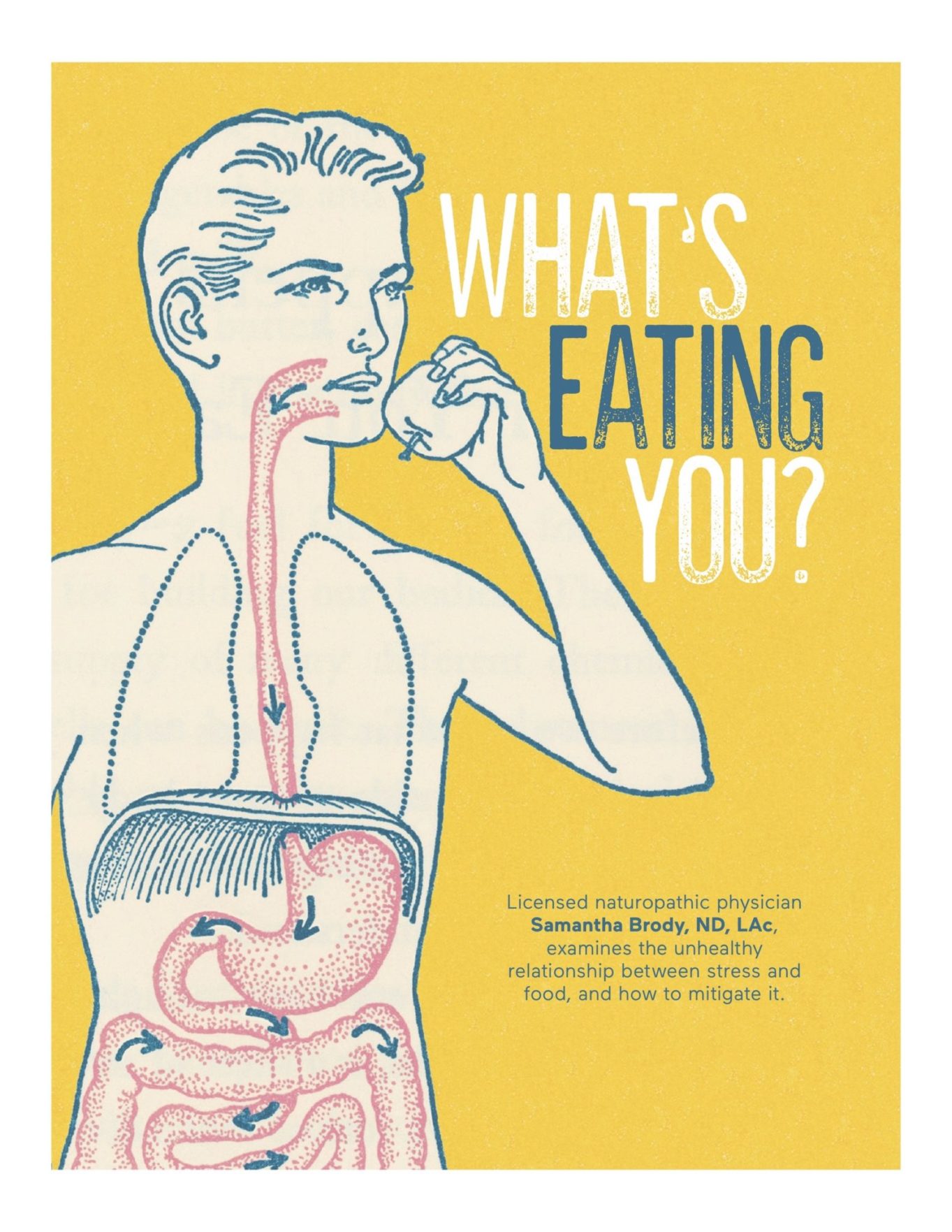What’s Eating You? The Link Between Stress and Food

Licensed naturopathic physician Samantha Brody, ND, LAc, examines the unhealthy relationship between stress and food, and how to mitigate it.
In my two decades of running an integrative primary care practice and many years of writing about stress, one thing has repeatedly shown itself to be true:
The relationship between food and stress is intricately woven. Stress can cause us to overeat or undereat. It can also lead to poor food choices, which can in turn cause us physical and emotional stress. And these reactions are far more ingrained in us than you might think.
It’s believed that during human evolution, our brains became wired to do one of two things when under stress: avoid food or eat nutrient-dense foods. If you think about how our ancestors functioned, this programming makes sense. Avoiding food was tied to our fight-or-flight instincts; spotting a cheetah while you’re at the watering hole was not the time to spread out a picnic; it was time to make a run for it. Meanwhile, the instinct to eat was designed to help us protect ourselves from impending food shortages and threats that might require energy exertion, like making the sudden, and very necessary, sprint away from that cheetah. In this light, stress eating was a solid survival tactic.
Of course, that’s less likely the case today. While some contemporary stresses, such as getting rear-ended or catching whooping cough, can be life-threatening and require extra exertion to endure, most of the triggers that drive us to rummage through the fridge aren’t predicaments that require intense energy bursts or extra calories to support the effort. They’re small, everyday hardships, such as never-ending to-do lists, fifty-plus-hour workweeks, and a culture that tells us we’re not thin enough, pretty enough, young enough, or enough enough.
Unfortunately, our instincts don’t differentiate between the anxiety of a traffic jam or fight with our partner and an impending famine or cheetah attack, so we react with our pre-programmed response. For many of us, that’s eating. But we don’t usually reach for something wholesomely fortifying. We’re more likely to grab the comforting, calorie- and sugar-dense foods that would help us out if we did, in fact, need to catch a wild pig for dinner or outrun a T. Rex. Topping it off, the knowledge that eating poorly isn’t good for us often triggers guilt and more stress. And so the cycle goes.
The result is a triple whammy: The stress of life, the stress of what we eat, and then the stress of feeling bad about ourselves for stress eating. Even worse, over the long term, if we choose the carbohydrate- and sugar-laden foods that so often characterize stress eating, we increase our risk for disease and thus inadvertently add another layer of stress to our already overburdened bodies.
What, then, can be done? I recommend a simple, three-step approach that focuses on taking personal responsibility for your eating choices:
- Understand what exactly happens in your body when you overeat foods that are carbohydrate- and sugar-laden or foods that your body simply doesn’t like.
- Recognize what’s driving your food choices.
- Craft a proactive plan that allows for occasional indulgence (as long as you’re not dealing with a health issue that prohibits it) within a larger context that emphasizes food choices to actually reduce your stress rather than increase it.
What’s happening in your body
Our bodies simply aren’t designed to handle excessive amounts of refined carbohydrates and sugar. From what I see in my practice, what we typically think of as “moderation” isn’t moderate at all. We sometimes hear the 80/20 rule: that if we eat healthfully 80 percent of the time, we don’t have to worry about the other 20 percent. The problem with this theory is that what we think of as healthy often isn’t. Some common examples might be flavored lowfat yogurt (laden with sugar) or salad for lunch (not enough food). And even if your 80 percent is healthy, the other 20 percent is a considerable portion of your food intake.
Sugar has many negative effects on the body, and refined grains, such as white rice, lack the fiber and nutrients of whole grains and break down very quickly into sugar, which is in turn dumped more quickly into the bloodstream. Even if you don’t eat white rice or other refined grains knowingly, you may still be consuming plenty of them because they’re included in flour form in the majority of mass-market gluten-free products and gluten-free flour blends. Other refined grains commonly found in gluten-free recipes and products are tapioca starch and potato starch.
The amount of sugar your body needs to function isn’t much unless you are long-distance running, and too much can cause damage to your blood vessels and organs. Excess sugar in your system inspires inflammation in the body. And we now know that inflammation is the single most important driver of most modern diseases and aging: heart disease, arthritis, dementia, and any condition ending in “-itis.”
Healthy Alternatives to Everyday Eats
Make these simple swaps to get more nutritional bang for your bite.
fruit and other juices ————————-> whole fruit
granola bar————————-> raw nuts and seeds
cereal————————-> eggs, spinach, and turkey bacon
blueberry yogurt————————-> plain Greek yogurt
sweetened nondairy milk————————-> unsweetened nondairy milk
gluten-free pretzels————————-> whole-grain crackers
white rice noodles————————-> brown rice noodles
cooked white rice————————-> cooked brown rice or quinoa
potato chips————————-> quinoa or lentil chips
french fries————————-> roasted green beans
candy bar————————-> 80% dark chocolate topped with almond butter
Sweet Revenge
Next time you read a label’s sugar content, digest this: 1 teaspoon of sugar equals 4.2 grams, which means the following foods, and many others, likely contain more sugar than you realize:
PRODUCT SUGAR CONTENT
Starbucks Grande 42 grams/
Chai Latte 10 teaspoons
Fage 2% Split Cup 29 grams/
Honey Yogurt 6.9 teaspoons
PF Chang’s 90 grams/
Spicy Chicken 21.4 teaspoons
Lara Bar Chocolate 23 grams/
Chip Brownie 5.47 teaspoons
Odwalla Super 56 grams/
Protein drink 13.3 teaspoons
Izze’s sparkling 26 grams/
pomegranate juice 6.2 teaspoons
The effects of consuming refined sugar and refined carbohydrates aren’t limited to the physical. Eating these things, or overeating in general, causes us to produce hormones in our brains that actually mimic some feel-good recreational drugs. In addition to comfort and a pleasing taste, certain foods also lead to a production of dopamine, serotonin, and endorphins, all of which briefly make us happier in one way or another—and also make us want to keep the high going by consuming more sugar.
Given the very real, albeit fleeting, emotional benefits, it’s easy to understand why we continue habits that ultimately cause us more harm than good. This leads directly to the next part of breaking the cycle of stress eating: understanding what drives us to stress-eat in the first place.
What’s driving your food choices
Stress happens. But if we’re mindful, we can control how we respond to it.
The first step when you’re craving sweets or carbs is just to sit with it. Really sit. Feel the discomfort. It’s most often this discomfort—this feeling we are driven to avoid—that instigates the craving in the first place. If you take the time to identify your triggers, you are taking the first step to dealing with it. Feeling sad? Lonely? Angry? Frustrated?
Some of us just need to be aware of the emotions that we are burying with food in order to stop. Others need more support to look deeply at what is driving their need to eat in this way.
In the end, you’re an adult and you get to decide what you are going to put in your mouth. If you want to eat a box of gluten-free donuts, you can. You also, as an adult, can take the time to really look at what is driving your choices. I often tell my patients that if they really want to avoid certain foods or choices and they can’t, even after looking at the underlying reasons they want them and how it serves and doesn’t serve them to eat the foods, then it’s an issue to address in counseling.
A plan for eating success
Once you recognize your triggers, crafting a plan to address them is easier than it sounds.
First, you need to be very clear about what’s most important to you. To do this you have to take the time to drill down to what your values are and how you want to be in the world—perhaps energized, agile, healthy, and happy are words you’d use to describe your best self. Once your values and goals are clear, it becomes much easier to make choices on a day-to-day basis, from the foods you eat to with whom you spend your time. Making choices based on your values is one of the best ways to lower stress overall, as well.
Next, it’s time to become truly aware of what you’re choosing to eat and whether it’s actually good for you. Adjust your food choices accordingly. If your diet includes a lot of packaged foods, start by reading labels. When you do, you might be surprised to find that a cup of your favorite nonfat blueberry yogurt contains more sugar than two servings of Fruit Loops. Or that your favorite “whole-grain” gluten-free bread also contains a lot of starches and refined grains and very little fiber.
Finally, balance your carbs and sugar with protein and fat, and make sure you’re getting plenty of fiber. All of these things slow the body’s release of sugar into your bloodstream. While it’s better to avoid sugar in general, if and when you do eat it, make sure it’s not on an empty stomach or on its own.
If you are clear about what’s important to you, understand your motivations and choices, and apply your newfound wisdom to your food selections, you’ll be able to say yes to healthier foods and a healthier body and mind

